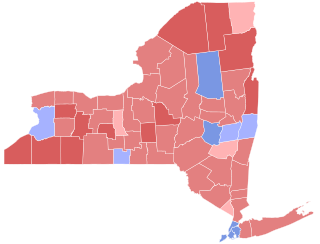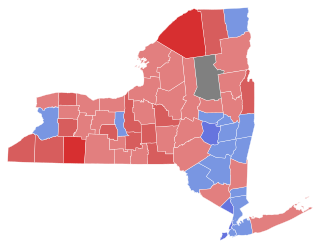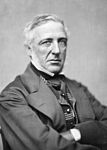History
The Constitutional Union state convention met on September 9 at Association Hall in Troy, New York. B. Davis Noxon [1] was temporary chairman and made a speech stating that the object of this political body was to stop the American Civil War. Eli P. Morton was chosen president of the convention. Ballots were taken for governor and lieutenant governor. The vote stood as follows. For governor: Horatio Seymour 32, John Adams Dix 20, Millard Fillmore 6, Frederick A. Tallmadge 1, James Brooks 1, Lorenzo Burrows 1. For lieutenant governor: William C. Hasbrouck 29, Burrows 13, Washington Hunt 8, Brooks 3, William Duer 2, Tallmadge 1. No ticket was nominated, the Constitutional Unionists instead joined the Democratic convention on the following day. [2]
The Democratic state convention met on September 10 at Tweddle Hall in Albany, New York. Henry C. Murphy was temporary chairman until the choice of Alonzo C. Paige as chairman. Ex-Governor Horatio Seymour (who was in office 1853–54, and had already twice lost the gubernatorial elections in 1850 and 1854) was nominated for governor by acclamation. Seymour then made a lengthy speech disagreeing with the political course of the Republican federal government. [3]
The Republican Union state convention, a gathering of Republicans and War Democrats, met on September 24 at Wieting Hall in Syracuse, New York. Ex-Chief Judge Alexander S. Johnson (a former Democrat) was temporary chairman until the choice of Henry J. Raymond as president. James S. Wadsworth was nominated for governor on the first ballot. Lyman Tremain (a former Democrat) was nominated for lieutenant governor. [4]

There have been 91 gubernatorial elections in the state of New York since 1777, with the most recent being held on November 8, 2022. The next election is scheduled to be held on November 3, 2026.

Horatio Seymour was an American politician. He served as Governor of New York from 1853 to 1854 and from 1863 to 1864. He was the Democratic Party nominee for president in the 1868 United States presidential election, losing to Republican Ulysses S. Grant.

The 1910 New York state election was held on November 8, 1910, to elect the governor, the lieutenant governor, the Secretary of State, the state comptroller, the attorney general, the state treasurer, the state engineer and two judges of the New York Court of Appeals, as well as all members of the New York State Assembly and the New York State Senate. The voters were also asked if they approved a $2,500,000 bond issue for the improvement and extension of Palisades Interstate Park, which was answered in the affirmative, with 349,281 For and 285,910 Against. A constitutional amendment which proposed to add two judges to the New York Court of Appeals and to increase the judges' salaries was rejected by a margin of only 292 votes, with 332,300 For and 332,592 Against.

The 1904 New York state election was held on November 8, 1904, to elect the governor, the lieutenant governor, the Secretary of State, the state comptroller, the attorney general, the state treasurer, the state engineer, the chief judge and an associate judge of the New York Court of Appeals, as well as all members of the New York State Assembly and the New York State Senate.

The 1902 New York state election was held on November 4, 1902, to elect the governor, the lieutenant governor, the Secretary of State, the state comptroller, the attorney general, the state treasurer, the state engineer and a judge of the New York Court of Appeals, as well as all members of the New York State Assembly and the New York State Senate.

The 1900 New York state election was held on November 6, 1900, to elect the governor, the lieutenant governor, the Secretary of State, the state comptroller, the attorney general, the state treasurer and the state engineer, as well as all members of the New York State Assembly and the New York State Senate.

The 1882 New York state election was held on November 7, 1882, to elect the governor, the lieutenant governor, the chief judge and a U.S. Representative-at-large, as well as all members of the New York State Assembly. Besides, two constitutional amendments were proposed - the abolition of tolls on the State canals, and to increase the number of justices on the New York Supreme Court - and were accepted by the electorate.

The 1898 New York state election was held on November 8, 1898, to elect the governor, the lieutenant governor, the Secretary of State, the state comptroller, the attorney general, the state treasurer and the state engineer, as well as all members of the New York State Assembly and the New York State Senate. This election is the most recent election to feature a candidate for governor of New York who eventually became both Vice President of the United States and President of the United States after serving as Governor of New York.

The 1856 New York state election was held on November 4, 1856, to elect the governor, the lieutenant governor, a Canal Commissioner, an Inspector of State Prisons and the Clerk of the Court of Appeals, as well as all members of the New York State Assembly.

The 1864 New York state election was held on November 8, 1864, to elect the governor, the lieutenant governor, a Canal Commissioner and an Inspector of State Prisons, as well as all members of the New York State Assembly.

The 1866 New York state election was held on November 6, 1866, to elect the governor, the lieutenant governor, a Canal Commissioner and an Inspector of State Prisons, as well as all members of the New York State Assembly. Besides, the voters were asked if a Constitutional Convention should be held in 1867, which was answered in the affirmative with 352,854 votes for, and 256,364 against the convention.

The 1868 New York state election was held on November 3, 1868, to elect the governor, the lieutenant governor, a Canal Commissioner, an Inspector of State Prisons and the Clerk of the Court of Appeals, as well as all members of the New York State Assembly.

The 1874 New York state election was held on November 3, 1874, to elect the governor, the lieutenant governor, a judge of the New York Court of Appeals, a Canal Commissioner and an Inspector of State Prisons, as well as all members of the New York State Assembly and one member of the New York State Senate.

The 1876 New York state election was held on November 7, 1876, to elect the governor, the lieutenant governor, a judge of the New York Court of Appeals, a Canal Commissioner and an Inspector of State Prisons, as well as all members of the New York State Assembly and two members of the New York State Senate. Besides, two constitutional amendments were proposed - to abolish the elected Canal Commissioners and appoint a Superintendent of Public Works instead; and to abolish the elected New York State Prison Inspectors and appoint a Superintendent of State Prisons instead - and both were accepted by the electorate.

The 1861 New York state election was held on November 5, 1861, to elect the Secretary of State, the State Comptroller, the New York State Attorney General, the State Treasurer, the State Engineer, a Judge of the New York Court of Appeals, two Canal Commissioners and an Inspector of State Prisons, as well as all members of the New York State Assembly and the New York State Senate.

The 1867 New York state election was held on November 5, 1867, to elect the Secretary of State, the State Comptroller, the Attorney General, the State Treasurer, the State Engineer, a Judge of the New York Court of Appeals, a Canal Commissioners and an Inspector of State Prisons, as well as all members of the New York State Assembly and the New York State Senate.

The 1879 New York state election was held on November 4, 1879, to elect the governor, the lieutenant governor, the secretary state, the state comptroller, the attorney general, the state treasurer and the state engineer, as well as all members of the New York State Assembly and the New York State Senate.

The 1895 New York state election was held on November 5, 1895, to elect the Secretary of State, the State Comptroller, the Attorney General, the State Treasurer, the State Engineer and a judge of the New York Court of Appeals, as well as all members of the New York State Assembly and the New York State Senate. Besides, the voters were asked if they approved of the State's issuing bonds for $9,000,000.00 to spend on canal improvements, which the electorate answered in the affirmative.

The 1863 United States Senate election in New York was held on February 3, 1863, by the New York State Legislature to elect a U.S. Senator to represent the State of New York in the United States Senate.

The 68th New York State Legislature, consisting of the New York State Senate and the New York State Assembly, met from January 7 to May 14, 1845, during the first year of Silas Wright's governorship, in Albany.



















